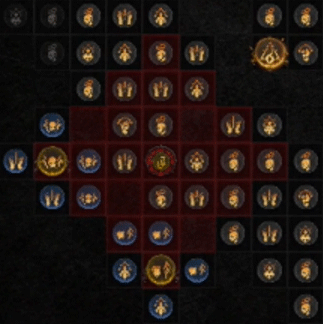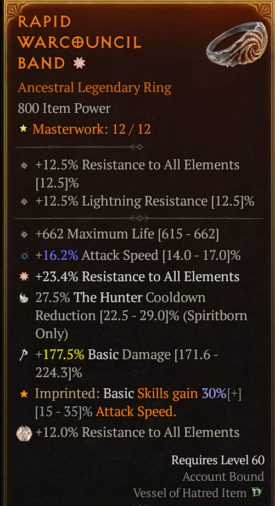Powering Up in Diablo 4
Last Updated:April 24, 2025|Changelog
Powering Up focuses on some of the most meaningful components of your character's progression in Diablo 4. No matter what activity you decide to engage with, you always accumulate the materials, experience, gear, and gold necessary to develop a fully decked-out endgame character. Our aim is to help you better manage those resources and prioritize certain progression paths to keep your character at its strongest.
Filling out Legendary Aspects
Early on, it's unlikely to be fully equipped with Legendary Items, let alone the best-in-slot Legendary Aspects and Uniques necessary to strengthen or even enable your endgame build. This gear can drop randomly from virtually any source, but here are a few tips to help better target the items you need:
Season Journey
Starting in Season 4, the Season Journey rewards players with Legendary Items that are themed around a Skill or playstyle for each class. While some builds are better than others, getting any form of guaranteed Legendaries is better than known, especially if some or most can be carried over to a more desirable build.
For Season 6 - Season of the Hatred Rising, the following archetypes are what each class focused on:
- Barbarian -Weapon Mastery/Weapon Swapping (Walking Arsenal Key Passive)
- Druid - Earth/Companions
- Necromancer - Shadow/Curses
- Rogue - Agility/Stealth
- Sorcerer - Elementalism/Conjurations
- Spiritborn - Mixed/All
Codex of Power
As of Season 4, all possible Legendary Aspects are available to be Imprinted onto Rare or Legendary items in the Codex of Power. Each Dungeon still has the same associated Legendary Aspect as before that you need to unlock by completing the Dungeon. Now, when you find a previously drop only Legendary item, you can go to the Blacksmith and Salvage it to add the power (at its current strength) to the Codex of Power! This allows any power to be added and Imprinted over and over again without having to hoard Aspect Crystals any longer.
Gambling Murmuring Obols
Collecting Murmuring Obols from Reward Chests at the end of Local Events and Dungeon Events allows for one of the best methods to target specific Legendary Aspects not found in the Codex. To spend these, visit the Purveyor of Curiosities in any of the capital cities to gamble for particular item slots. When choosing which item slot to gamble, it's important to understand which category a particular Legendary Aspect belongs to. This determines what slot you should gamble.
As an example, Resource Aspects can only be found or Imprinted onto Rings and Amulets, while Offensive Aspects can be found on Weapons, Off-hands, Gloves, Rings, or Amulets. Once you've mastered this concept, it becomes easier to spend your Obols in a way that maximizes your chances of obtaining a key Aspect!
Tree of Whispers Collections
Similar to gambling at the Purveyor of Curiosities, Collections acquired from the Tree of Whispers include gear from your choice of three random item slots. In higher difficulties, this gear often includes one or more Legendary Items. This is how you get your first Sigils for Nightmare Dungeons, too! The upshot of farming for Collections is that many of these objectives coincide with other productive activities, including World Bosses, Local Events, and Dungeons. To maximize efficiency, consider prioritizing content that overlaps with Whispers of the Dead objectives to kill two birds with one stone.
Helltide
Certain zones in a region periodically become corrupted by Helltide. Enemies that spawn within these zones drop Aberrant Cinders, which you can use to unlock chests in the affected zones called Tortured Gifts. The gear from these chests is slot-specific and much rarer, often including Legendary or Unique items. Make the most of these events for gear upgrades and crafting materials as well.
Upgrading, Socketing, and Enchanting Gear
As you progress into better and more permanent pieces of gear, you want to devote your gathered resources towards improving those items you intend to keep. Even early on, investing a little bit in improving your gear at the Blacksmith can make a noticeable difference as you level. There are a handful of ways that items can be improved:
- Tempering - Tempering your gear allows you to add specific Affixes to a Rare 1 time, and Legendary item up to 2 times. These Affixes can be your run of the mill, + % Movement Speed, or + % Resistance all the way to adding additional projectiles to a certain skill. Tempering a few pieces along the way can drastically effect your power. Always be mindful of the Upgrade cost to avoid going broke!
- Socketing - Adding sockets to items allows you to gain additional bonuses from the Gems and Skulls acquired throughout the game. Though items can naturally roll with sockets, your best items (Ancestrals) may need to have them added by using Scattered Prisms. These are generally found from World Bosses, but can be obtained rarely from other enemies.
- Enchanting - Best reserved for endgame pieces due to the cost, Enchanting at the Occultist allows you to reroll undesirable affixes off a piece of gear in the hopes of receiving a better affix in return. This action can only be performed on one affix per item, making the item account-bound, so choose wisely! Always be mindful of the Enchanting cost to avoid going broke!
- Masterworking - Masterworking is similar to the now defunct Upgrading system. You can take an Ancestral Legendary or Unique item and upgrade it up to 12 times. Each rank increases all the Affixes on the item by 5%, with ranks 4, 8, and 12 being massive 25% critical upgrades. These three specific upgrades can randomly hit three different Affixes, the same one twice and another once, or one Affix all three times! That's the RNG in the system. If you do not like how your item is progressing, you can reset the upgrades for a cost and try again. The main materials used to fuel this system can be consistently acquired by running Nightmare Dungeons.
Rounding Out Renown
Progressing Renown in each of the game's 6 regions grants you a set of account-wide unlocks. This includes increases to your maximum Potion Charges and Obol capacity, and precious Skill and Paragon Points. By late game, these additional points prove invaluable, so it's never a bad idea to work on your Renown as you traverse through each region. Note that you don't need to fully complete all 6 activities that contribute to Renown to receive the maximum benefit from that region.

One of the most efficient ways to progress a region's Renown while boosting your character power is by discovering Altars of Lilith. These Altars provide permanent, account-wide bonuses to Life, Attributes, maximum Obol capacity, and even Paragon Points! Consequently, many players seek these Altars even after they've already completely unlocked the Renown bonuses in each region. Discovering Altars of Lilith, by itself, doesn't provide enough Renown to fully unlock a region's bonuses, but picking them up along the way saves you from backtracking later.
Acquiring and Leveling Glyphs
After advancing to Torment difficulties, Glyphs provide an extraordinary source of power that scales throughout the endgame. When placed in a Glyph Socket on your Paragon Board, they grant a wide array of offensive, defensive, or utility-based stats that are either unattainable through other means or dwarf comparable sources of the same bonus.
Acquiring Glyphs
Glyphs are found in any activity in Torment Difficulties. They are leveled by completing The Pit, which solidifies this as the cornerstone endgame activity. Obtaining Glyphs is still random and may take some time to acquire all you need for your build, so be patient and they will eventually appear.
Leveling Glyphs
With each level, the effectiveness of Glyphs' inherent bonuses scales higher. At Level 15, Rare Glyphs expand from a Radius of 3 to 4, and at Level 46, Rare Glyphs turn into Legendary Glyphs and expand their Radius of 4 to 5. The increase in Radius determines the number of Paragon Nodes that they can affect (or those that affect them). Level 15 proves to be the turning point for leveling most Glyphs, as some Paragon Board Glyph Sockets require a Radius of 4 to fully unlock, dipping into the nearby Magic and Rare Nodes. As such, we recommend leveling each Rare Glyph you intend to use to at least Level 15 before moving on to the next. When all of your Glyphs have reached this threshold, then consider progressing them to their next Radius increase at 46.


Acquiring Ancestral and Unique Items
In Diablo 4, the selected difficulty dictates whether or not you can obtain the most rare items in the game.
- In Standard Difficulties, regular items drop.
- In Torment Difficulties, Ancestral Legendary items and Mythic Uniques start dropping.
As you progress through the higher difficulties, upgrading your items to these higher rarities is a top priority. The effects of some Unique items are build-enabling, and those that aren't are still impactful. The processes by which we acquire these items are the same. Just be sure to play on the highest level of difficulty your build can handle efficiently to maximize your chances of dropping Ancestral Legendary items, Uniques, and Mythic Uniques.

Summary
- Utilize the Codex of Power, Murmuring Obols, and Tree of Whispers Collections to round out your character's Legendary Aspects.
- Temper, Masterwork, Socket, and Enchant your gear at the various vendors in town to improve their quality.
- Complete Renown objectives in each of the world Regions, including Altars of Lilith, to receive permanent, account-wide stat bonuses.
- After reaching level 60, you unlock The Pit and can begin leveling up Glyphs.
- At higher difficulties, replace your gear with Ancestral Legendary items, or even a Unique!
Credits
Written by IBoilerUp
Reviewed by Avarilyn